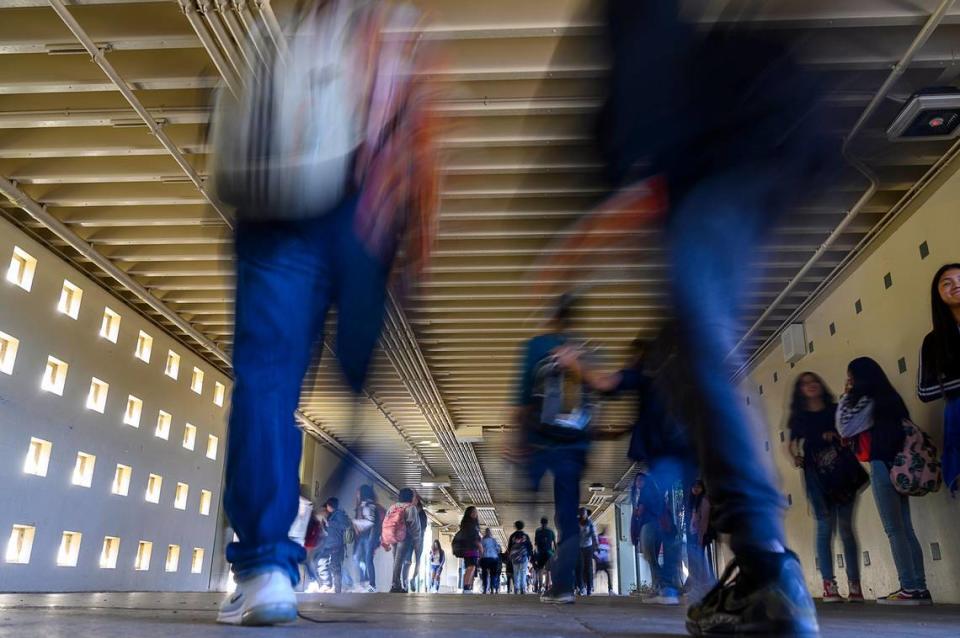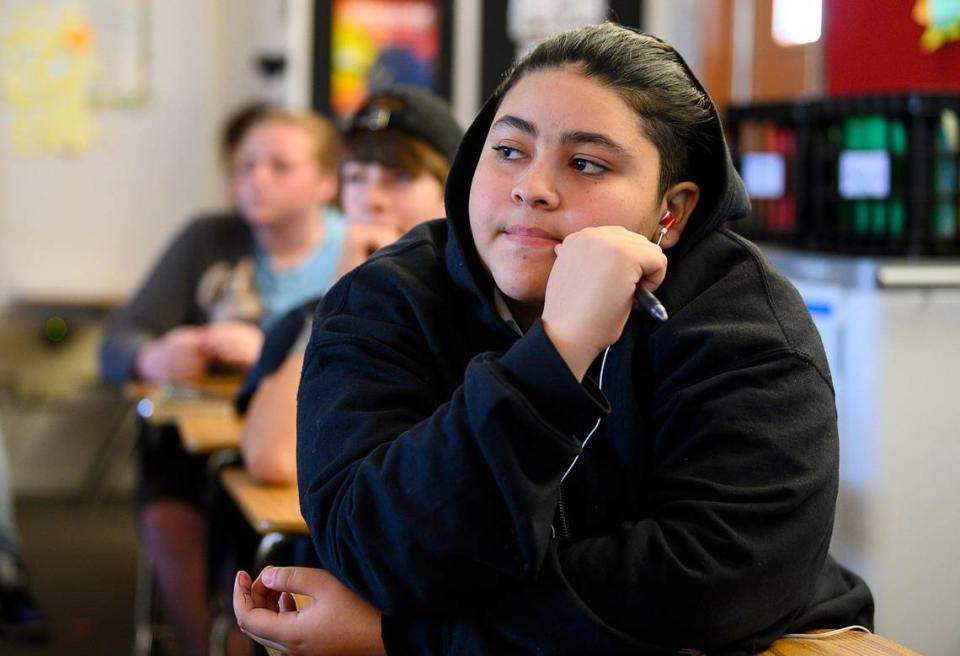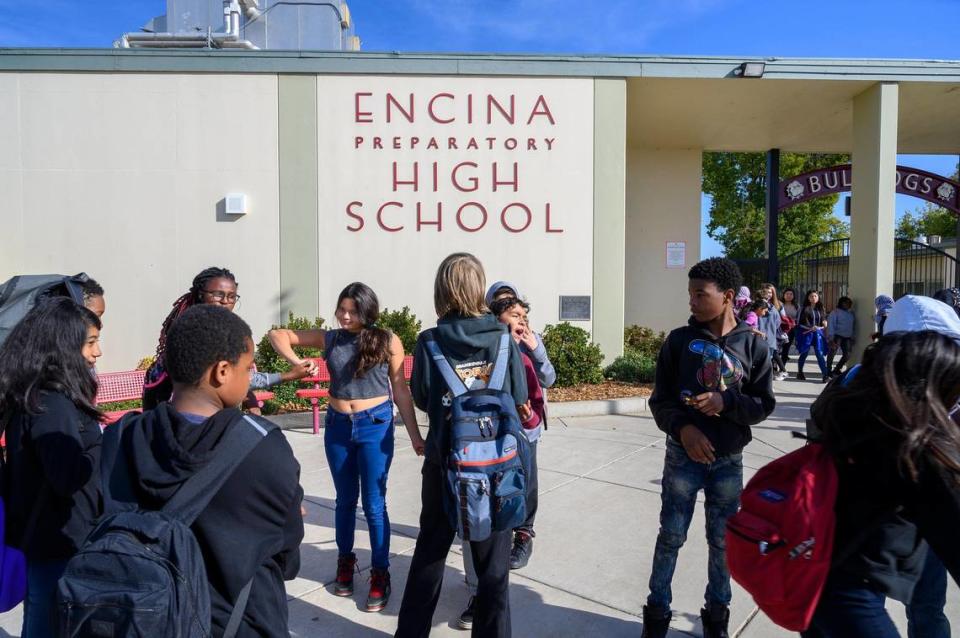A Nobel Prize winner graduated from this Sacramento school. Why it’s now being left behind
The neighborhood where Jon and Jen Schwedler are raising a family, nestled between Fair Oaks Boulevard and the American River, is a suburban oasis. Large ranch-style homes, some with palm trees in the yards, line the quiet side streets. Parts of the neighborhood are a short walk from riverfront trails and high-end restaurants.
The area is also zoned for Encina Preparatory High School, a public school rich in history. And like many of their neighbors, the Schwedlers chose not to enroll their oldest son at Encina – the lowest-performing large school in the Sacramento region.
“Basically what I looked for was performance, programs and proximity,” Jen Schwedler, a former public school teacher, said.
Encina is between very wealthy and very poor neighborhoods, but its student body is overwhelmingly disadvantaged. Meanwhile, families in the area with the financial means send their kids elsewhere for high school, contributing to the steady decline of a school that has produced a Nobel Prize winner, local business leaders and the bass player for the Eagles.
The result is a campus confronting socioeconomic segregation and, despite what students describe as a nurturing environment and supportive teaching staff, struggling to serve a student body of refugees and children living in poverty.
Neighborhoods zoned for Encina have a stark economic divide.
To the south are wealthy neighborhoods such as Sierra Oaks Vista, with majestic trees and multi-million dollar estates. Just 5 percent of middle and high school students live in poverty and most families earn at least $100,000 a year, according to the latest census estimates.
Farther north – closer to the Encina campus – poverty reigns.

Roughly half the middle and high school students in those neighborhoods live in poverty, and just 13 percent of the families make at least $100,000 a year – less than half the Sacramento County rate. Large apartment complexes line Howe Avenue and home lots are far smaller than those less than a mile away.
Most of Encina’s attendance zone covers the high-poverty areas. And 96 percent of the school’s students are eligible for free or reduced lunch, which is available to families earning up to 185 percent of the poverty line, state data show. That suggests an overwhelming majority of wealthy families living in the school’s attendance zone choose to send their kids elsewhere.
Two and a half miles away sits Sierra Oaks Elementary, a K-8 school, where the Schwelders’ son currently attends eighth grade. About 57 percent of students tested met English standards and about 44 percent met math standards, both above the overall San Juan Unified School District results.
He’s headed to Rio Americano High School, along with the majority of his classmates. While Encina is the Schwedlers’ home school, in an open enrollment district such as San Juan Unified, the family is able to choose which school their children will attend.
Not many students finish middle school at Sierra Oaks and then enroll in Encina.
After eighth grade, Sierra Oaks feeds into both Encina and Rio Americano, largely depending on whether a student lives east or west of Watt Avenue. Of the 76 students who finished eighth-grade at Sierra Oaks last year and remain in the San Juan district, just three attend Encina, district data show.
That’s largely because Encina can’t shake its reputation for poor academic standards on standardized testing, one of the few ways people choose a public school. In the 2018-19 school year, just 3 percent of Encina’s students met math standards, lower than any other school in the Sacramento region with more than 200 students taking end-of-grade tests. Just 9 percent of its students met English standards, also the lowest in the region for schools that size.
Excluding special education students, about 64 percent of high school students in Encina’s attendance zone chose to attend a different school during fall 2019, according to San Juan Unified data. The high schools drawing the most students from Encina’s attendance area were El Camino (440 students), Rio Americano (292) and Mira Loma (253).
Open enrollment in schools
California education code began requiring open enrollment in all school districts in 1994. The intent was to provide families with the freedom to select their school, regardless of location. The code came with exceptions; students could not displace other students living in the attendance area, for example.
San Juan Unified approved its own open enrollment policy in 1992.
“Losing enrollment to private schools, charter schools starting to come online and wanting to offer people choice of programs were all part of the conversation,” said San Juan Unified spokeswoman Raj Rai.
Like Sacramento City Unified, and other districts in the state, San Juan Unified has no intention of ending its open enrollment program. But some argue those systems create socioeconomic segregation, where wealthy families choose to send their children to some schools while low-income students end up at others.
“I think school choice is a good thing, but I don’t know that it’s serving our neighborhood well,” said Jen Schwedler.
Gary Orfield is a UCLA education and law professor and author of the book, “Educational Delusions? Why Choice can Deepen Inequality and How to Make Schools Fair.” He led much of the work for the UCLA Civil Rights Project and has conducted more than 50 years of research on school choice and integration.
When you give families school choice, Orfield said, it often leads to inequality. And that is precisely what happened with Encina.
Orfield said schools segregated by income levels often have fewer family and community resources. While schools within the same district are often funded equally, experienced teachers often leave low-income schools.
“What (schools) also lose is the ability to teach kids to live and work across those racial and class lines, which they have to do as adults,” Orfield said. “It’s much easier to learn that at school than to hit the wall as an adult.”
Racial, social and socioeconomic integration helps students succeed, according to research by Rucker Johnson of UC Berkeley’s Goldman School of Public Policy, who looked at four decades of studies that prove students fare better in integrated schools. That stems from the “rising tide lifts all boats” theory, and the idea that students achieve more when they work together.
Asked what the school could do to attract more students from affluent neighborhoods, school officials said their focus is on serving students currently at the school.
“How do we best serve the students who come here everyday?” Community Partnership Coordinator and English teacher Barry Roth asked. “There is a lot to focus on. As much as we want kids to come here, our enrollment has been growing every year. We need to serve the students already here.”
Orfield said while open enrollment policies will continue dividing students based on race and class, ending the policy is not the solution.
“There should be school choice, but there should be controls on it. There should be an effort to recruit diverse classes, and a preference to increase diversity,” Orfield said. “We have to combine choice with equity polices.”
Inside Encina campus
In Kim Minugh’s English class, the walls are adorned with posters that read, “Schools not Prisons.” Her windows are painted with the quotes, “Literacy is not a luxury, it is a right and a responsibility,” and “You cannot uneducate the person who has learned to read.”

Some students at Encina are three grades below reading level, while others are at a college reading level. District officials said if they could get students to make gradual but significant improvements in their reading levels, that would be meaningful progress.
The school provides Advanced Placement classes, and all students have access to the Advancement Via Individual Determination (AVID) program, which is designed to help underachieving students prepare for college.
Although the school works to ensure every student is qualified to enter college and succeed at a four-year university, about 40 percent of students who graduated from Encina in the 2017-18 school year went to college within a year, well below the countywide rate of 65 percent, state data show.
Students who met with The Sacramento Bee sang the school’s praises, saying the student body is inclusive and welcoming. A good school should not only be measured by test scores or reputation, but by how supported students feel, they said.
Sayra Gutierrez, 17, moved to Sacramento from Kentucky, where she was one of two Mexican students at her school.
“When I came here, it was all very different, because I had more people that looked like me, that knew my culture, traditions, and my home language,” Gutierrez said. “When I first came here I was really shy. Now I can be myself and I am more confident. I am who I am and I don’t have to hide it.”

Robina Haqiqi, 16, called the student body her family.
“I found all of my talents here,” said Irish Branner, 15. She sings, plays basketball and dances — all passions she was encouraged to develop at Encina.
Branner, who is African American, attended elementary school in Elk Grove. She said she won’t forget how students would tell her they wouldn’t play with her unless she straightened her hair. Now at Encina, with a far more diverse student body, some of her friends are the children of Afghan refugees and those granted Special Immigrant Visas for their service to U.S. and coalition forces.
Teachers are heavily engaged with their students, regularly checking in on their lives at home and encouraging them to practice their English. Student-led parent-teacher conferences are held about five weeks into the school year. Students share goals, show samples of their coursework and chart the progress they have made.
Angelique Gauthier, 17, whose father can’t attend the meetings due to work, is always accompanied to her conference by San Juan Unified board president Pam Costa.
“She moved her whole schedule around to meet with me, and from then on she’s been to every single (conference) up to senior year,” Gauthier said. “That to me meant a lot. I give her feedback about the school, and updates on my life.”
The conferences help students involve their parents in their academics, and students are able to hold themselves accountable. Their annual goals are academic – Ezra Lee, 16, wants a 3.5 GPA – and other goals are personal. Davell Perry, 17, wants to work on being more well rounded and develop tangible skills that he will need in the real world.
Refugees, immigrants at Encina
About 36 percent of Encina’s students are English Language Learners, compared to the school district’s overall rate of 14 percent, and California’s overall rate of 20 percent. Those students’ language skills vary – some do not speak, read, write or understand English well because it’s not their first language.
With new Common Core approaches in standardized testing, many students relatively new to U.S. schools struggle to understand word problems, read directions on a computer screen or read directions at all.
Four of the five elementary schools with the highest percentage of English language learners in the San Juan district feed into Encina. Many of the students at those schools are immigrants and refugees.
Encina has long absorbed these students because of Arden Arcade’s high immigrant and refugee population. Several refugee service centers are in the area, including International Rescue Committee, which helps refugees and new immigrants resettle in Sacramento – among the top destinations for refugees in California.

More than a decade ago, Encina students were coming from Russia, Ukraine and the Congo. In recent years, Encina students arrived from war-torn Iraq, Syria and Afghanistan. But unlike past generations of immigrants, the latest wave of newcomers are choosing to settle in the Arden Arcade area long after taking part in the resettlement program. And that means their children are being educated in the area, too.
The school trains staff members on how to work with students who are refugees, many of whom are dealing with trauma. Students dealing with intense trauma have needs that are different than students who simply need tutors.
“It’s a hard conversation everyday,” Roth said. “The trauma that these students hold, it’s about the students’ abilities to focus.”
Gauthier, who graduates next spring, said that despite the school’s and students’ challenges, colleges should pursue students like those at Encina.
“You might not look at them first because their grades might not be the best, and they might have to seek extra help or have a language barrier,” she said. “But I feel if everyone got the chance to know what really goes on between the walls of this school, these are the students that are gong to go on and do great things.”

